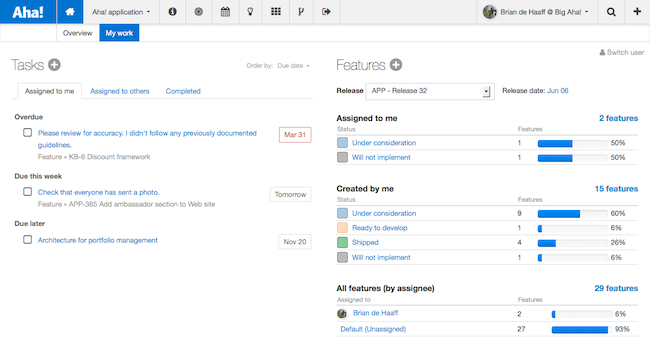
Manage Tasks, Assign Features, and Track the Product Team's Work
A product manager is nothing without a strong product team and capable engineers. You may have the greatest product strategy and visual roadmap ever crafted — but if you don’t have a team to deliver the software and new customer experience you simply have a collection of words and pretty pictures. This is why it’s critical for product management software to be based around the concept of a product team and the work they are doing.
We think the basis of every great product is the team that works on it — and that team is naturally cross-functional because customer experiences don’t start and end with the technology. For growing technology companies it’s important to organize a product or core team of leaders who can provide insight into and take ownership over key efforts within their organization. This is necessary to get ready to provide customer delight at every turn. A typical product team is led by product and includes leaders from engineering, program management, sales, support, ops, and marketing.
With the product team in mind, we just released significant enhancements to Aha! to allow cross-functional groups to manage the actual work that needs to be tracked and completed. This includes improvements to how features can be assigned and their progress reported on. It also provided an opportunity to better integrate tasks (which are typically non engineering to dos) throughout Aha!
Here is what to look for in Aha!
A new “My work” screen If you are thinking more broadly about the entire customer experience it’s obvious that you need to track all of the technical and non-technical work that needs to be completed — in one place. And you probably want to see what you are on the hook for. We have added a new sub tab under the home icon for My work. This view allows you to see all of the work that you need to complete across tasks and features and when it is due. If you are a team lead or manager it also provides a useful way to switch user to see what various members of your team are working on (top right). And remember that throughout Aha! you can only see information related to the products that you have access to.
Enhanced layout for requirements, tasks, and comments This release also gave us the opportunity to rethink how we were laying out features as we took a hard look at improving how tasks and comments were used. You will now see that requirements are easier to handle and rearrange and can be collapsed to provide an at-a-glance view of their status. We also made the headers consistent across requirements, tasks, and comments.
Percent complete bars for release phases In a cross-functional team there are many activities that need to come together for a successful release or launch. These can all be tracked on the Releases Portfolio screen including all of the phases and milestones. Because many phases will be owned by non product managers or engineers on the team — it is now easy to create tasks for them. Click on a phase and add as many tasks as you need and assign them to the right people. And when you create tasks within a phase the phase now is automatically shaded based on the number of tasks that have been completed. This gives you a simple way to see how the team is progressing against key work. See the “Complete launch checklist” phase that is partially shaded.
It’s clear that customers benefit most when there is transparency and collaboration within the product team. These new product management software features are all now available and ready for your use.
If you like this — share a vote or comment on Hacker News.
==================
If you are not already an Aha! customer, you may want to sign up for a free 30-day trial of Aha! now to see why the best known software and Web companies are using Aha! to set brilliant product strategy, create visual roadmaps (without bugs), and build what matters. And if you are a Rails Developer or looking for a Marketing Director role — consider joining our rapidly growing team.
Follow Aha! co-founder and the author @bdehaaff
Follow Aha! @aha_io




